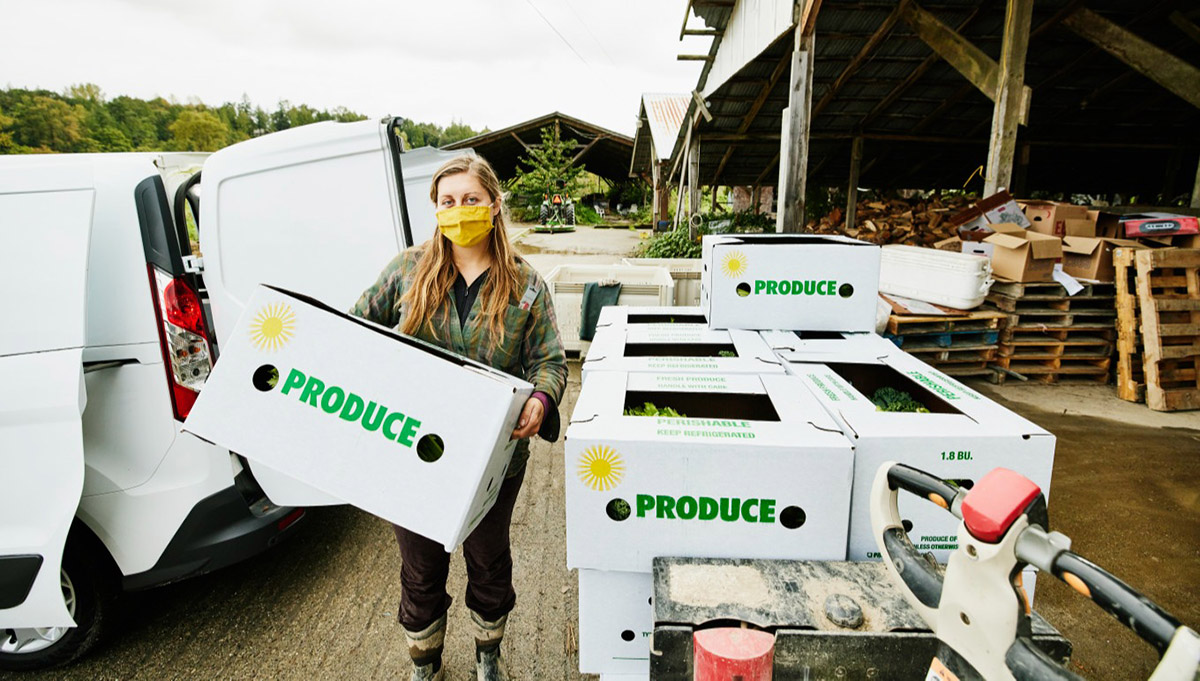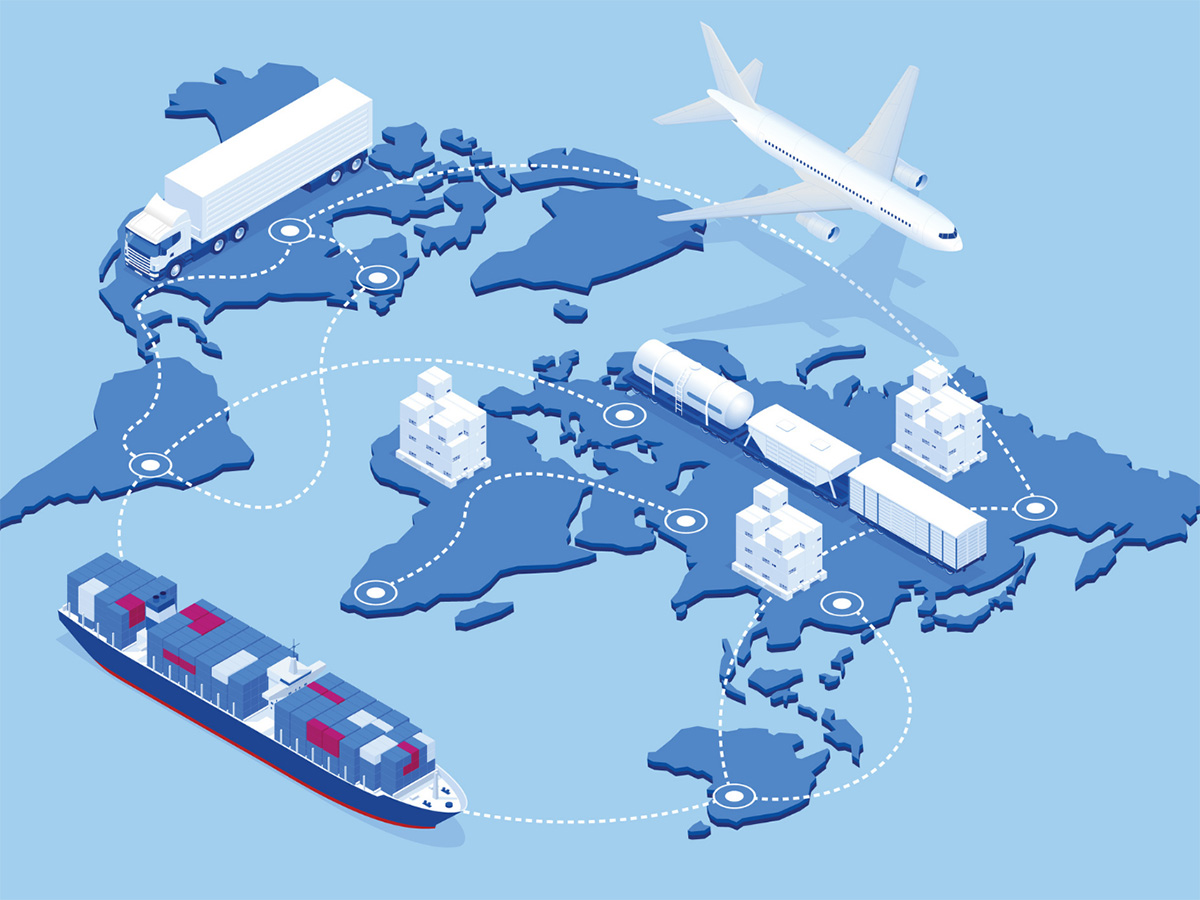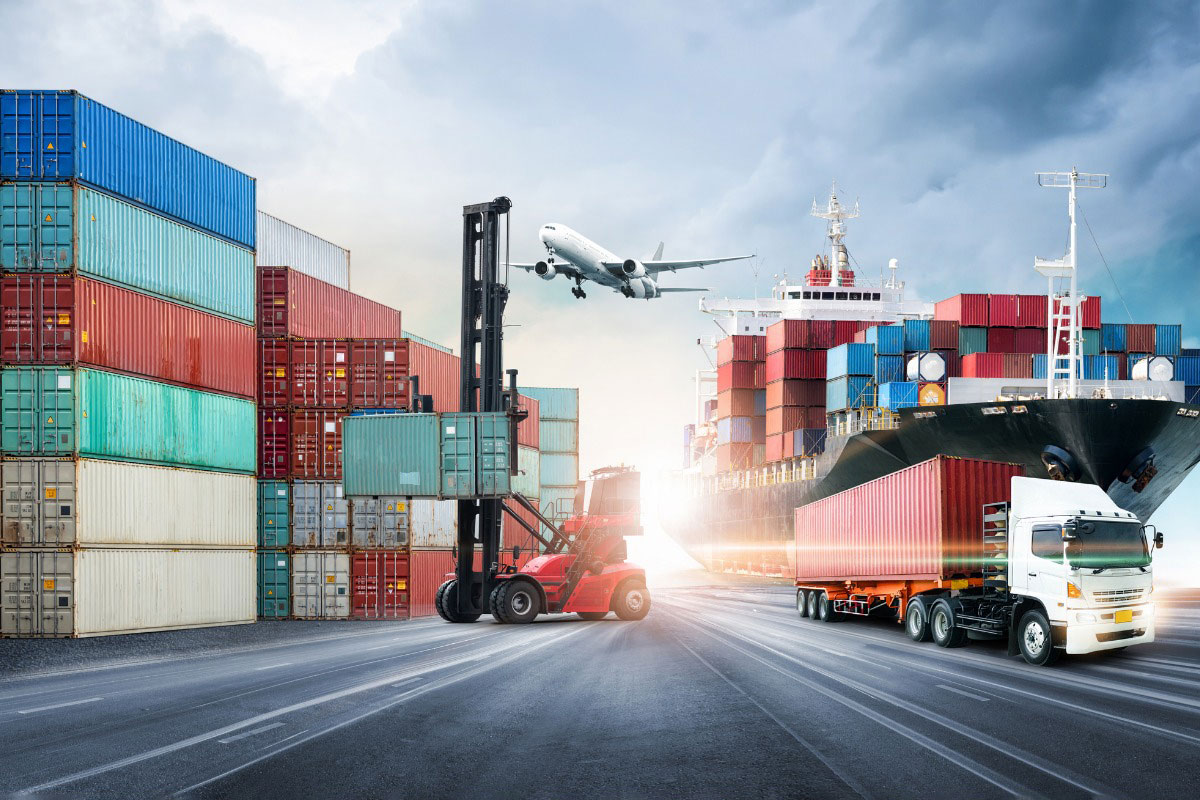

Finance
What Is The Food Supply Chain?
Published: October 19, 2023
Learn how finance plays a vital role in the food supply chain and ensures efficient management of resources to meet the demands of consumers.
(Many of the links in this article redirect to a specific reviewed product. Your purchase of these products through affiliate links helps to generate commission for LiveWell, at no extra cost. Learn more)
Table of Contents
- Introduction
- Definition of Food Supply Chain
- Key Components of the Food Supply Chain
- Farming and Agriculture
- Food Processing and Manufacturing
- Packaging and Distribution
- Retail and Consumer
- Challenges in the Food Supply Chain
- Impacts of the Food Supply Chain on the Environment and Health
- Future Trends in the Food Supply Chain
- Conclusion
Introduction
The food supply chain is a critical component of the global food system that ensures the efficient production, processing, packaging, distribution, and consumption of food products. It encompasses a complex network of organizations, individuals, and activities involved in bringing food from farm to table. Understanding the food supply chain is essential for ensuring food security, sustainability, and quality.
The food supply chain plays a vital role in the global economy, providing employment opportunities and contributing to economic growth. It connects various sectors, from farming and agriculture to food processing, packaging, distribution, and retail. Each step in the supply chain is crucial for ensuring that safe, nutritious, and affordable food reaches consumers.
In recent years, there has been an increased focus on the importance of a secure and resilient food supply chain. Factors such as population growth, climate change, and changing consumer preferences have highlighted the need for a more sustainable and efficient system. Additionally, the COVID-19 pandemic has further underscored the significance of a robust food supply chain and the need for contingency plans to address disruptions.
This article aims to provide an overview of the food supply chain, its key components, challenges, and the impact it has on both the environment and human health. We will also explore future trends and innovations in the food supply chain to meet the evolving needs of a growing population in a sustainable way.
Definition of Food Supply Chain
The food supply chain can be defined as the process of producing, processing, packaging, and distributing food products from the point of origin (usually a farm) to the end consumer. It involves a series of interconnected stages that ensure the safe and efficient movement of food through various channels.
The food supply chain begins with agricultural activities such as crop cultivation, livestock rearing, and fisheries. Once the raw materials are harvested or produced, they are sent to food processing facilities, where they undergo transformation to create value-added products. This includes activities such as sorting, cleaning, cutting, cooking, and packaging.
After processing, the food products move to the packaging and distribution stage. Packaging ensures the protection and preservation of the products during transit and storage. Distribution involves the logistics of transporting the packaged food items to retailers, supermarkets, restaurants, and other food outlets.
Finally, the last stage of the food supply chain involves the retail and consumer sector. This is where consumers purchase the food products for their personal consumption. The retail sector includes grocery stores, farmers’ markets, online platforms, and other establishments where food is sold.
The food supply chain is characterized by its complexity and interdependence. It requires coordination and collaboration among numerous stakeholders, including farmers, processors, manufacturers, distributors, retailers, and regulatory authorities. Each stakeholder plays a vital role in ensuring that food is produced, processed, and delivered safely and efficiently to meet consumer demand.
It is important to note that the food supply chain is not limited to a specific geographical area. It is a global network that encompasses both domestic and international trade. Products can be sourced from various regions, and the supply chain ensures that they reach consumers regardless of their location.
Overall, the food supply chain is a dynamic and intricate system that strives to provide a consistent supply of safe, nutritious, and affordable food to meet the needs of a growing global population.
Key Components of the Food Supply Chain
The food supply chain is comprised of several key components, each playing a crucial role in ensuring the efficient flow of food from producers to consumers. Understanding these components is essential for optimizing the supply chain and addressing challenges that may arise along the way. Here are the main components:
- Farming and Agriculture: This is where the food supply chain begins. Farmers and agricultural workers cultivate crops, raise livestock, and engage in fisheries to produce the raw materials needed for food production. This component involves various activities such as land preparation, planting, nurturing, and harvesting.
- Food Processing and Manufacturing: After the raw materials are harvested, they undergo processing and manufacturing to transform them into value-added food products. This component involves activities such as sorting, cleaning, cutting, cooking, and packaging. Food processing facilities use specialized equipment and techniques to ensure product safety, quality, and shelf life.
- Packaging and Distribution: Once the food products are processed, they need to be appropriately packaged for protection and preservation during transportation and storage. Packaging materials and techniques are chosen based on the specific requirements of each product. Distribution involves the logistics of transporting the packaged food items to various retail outlets, wholesalers, and other intermediaries in the supply chain.
- Retail and Consumer: The retail sector is the final link in the food supply chain, where consumers purchase the food products for their personal consumption. This component includes grocery stores, supermarkets, farmers’ markets, online platforms, and other establishments where food is sold. Retailers play a vital role in ensuring product availability, offering a variety of choices, and providing a seamless shopping experience for consumers.
These key components of the food supply chain are interconnected and rely on effective communication, collaboration, and coordination among stakeholders. Any disruption or inefficiency in one component can have a ripple effect on the entire supply chain, impacting the availability and quality of food for consumers.
Moreover, advancements in technology and data-driven tools have become increasingly important in managing the food supply chain. This includes the use of inventory management systems, traceability technologies, and real-time monitoring to enhance efficiency, reduce waste, and ensure food safety throughout the supply chain.
By understanding and optimizing the key components of the food supply chain, stakeholders can work collaboratively to ensure a resilient, secure, and sustainable system that meets the ever-changing demands of consumers while minimizing environmental impact.
Farming and Agriculture
Farming and agriculture are the foundational components of the food supply chain. This component involves the cultivation of crops, raising of livestock, and fisheries to produce the raw materials needed for food production. It plays a vital role in ensuring a steady supply of fresh and nutritious ingredients for the food industry. Here are the key aspects of farming and agriculture in the food supply chain:
- Crop Cultivation: Farmers play a crucial role in growing a wide range of crops such as grains, fruits, vegetables, and legumes. They utilize various farming techniques, irrigation systems, and pest management strategies to ensure optimal growth and yield. Crop cultivation requires careful planning, including choosing suitable varieties, preparing the soil, and managing weather conditions to maximize productivity.
- Livestock Rearing: Livestock farming involves the raising of animals such as cattle, poultry, sheep, and pigs for meat, dairy products, and other by-products. Farmers ensure the well-being of the animals by providing appropriate shelter, feed, and veterinary care. Livestock rearing requires expertise in animal husbandry, genetics, nutrition, and disease prevention to ensure the production of high-quality animal products.
- Fisheries: Fisheries contribute to the food supply chain by harvesting fish and other aquatic organisms from rivers, lakes, and oceans. Fishermen employ various fishing techniques such as netting, trapping, and angling to capture marine life sustainably. Fisheries management is crucial in maintaining the ocean’s biodiversity and preventing overfishing to ensure the long-term viability of this resource.
Farming and agriculture are heavily influenced by factors such as climate, soil fertility, water availability, and market demand. Advancements in agricultural technology have played a significant role in increasing productivity and efficiency. For example, the use of precision agriculture tools, such as GPS-guided machinery and drones, allows farmers to optimize crop production and reduce waste.
Sustainable farming practices are gaining prominence in the food supply chain. Farmers are adopting methods that minimize the use of synthetic fertilizers, pesticides, and herbicides while promoting soil health, biodiversity, and water conservation. Organic farming, agroforestry, and regenerative agriculture are examples of sustainable approaches that prioritize environmental stewardship and long-term sustainability.
Additionally, agricultural research and development are critical for innovation and improvement in the farming sector. Scientists and agricultural experts work on developing new crop varieties, improving crop resilience to climate change, and enhancing agricultural practices to ensure greater food security and environmental sustainability.
Farming and agriculture are the backbone of the food supply chain, providing the essential raw materials needed for food production. By adopting sustainable and innovative practices, farmers can contribute to a resilient and efficient supply chain that meets the demands of a growing population while safeguarding the environment for future generations.
Food Processing and Manufacturing
Food processing and manufacturing are crucial components of the food supply chain that involve transforming raw agricultural materials into processed food products ready for consumption. This stage adds value to the raw ingredients, enhances their shelf life, and creates a variety of food options for consumers. Here are the key aspects of food processing and manufacturing:
- Sorting and Cleaning: Raw agricultural materials, such as fruits, vegetables, and grains, undergo sorting and cleaning processes to remove impurities, dirt, and foreign particles. This ensures that only high-quality ingredients are used in the production process.
- Cutting, Cooking, and Mixing: Food processing facilities utilize machinery and equipment to cut, cook, and mix ingredients, creating the desired texture, flavors, and consistency in the food products. Techniques such as blanching, steaming, baking, and frying are employed to prepare ingredients for further processing.
- Packaging: Once the food products are processed, they are packaged to protect them during transportation, storage, and consumption. Packaging materials range from flexible plastics and cardboard to glass jars and metal cans, depending on the specific requirements of each product.
- Preservation and Flavor Enhancement: Food processing often involves techniques for preserving the quality and shelf life of products. This includes methods such as canning, freezing, drying, and adding preservatives. Food manufacturers may also incorporate ingredients like spices, seasonings, and additives to enhance the flavor, appearance, and overall sensory experience of the final product.
- Quality Control and Food Safety: Food processing facilities have rigorous quality control measures in place to ensure the safety and integrity of the products. This includes testing for contaminants, monitoring for allergens, and adhering to strict sanitation protocols. Compliance with food safety regulations and certifications is of utmost importance in maintaining consumer trust and confidence.
Food processing and manufacturing take place in facilities ranging from small-scale operations to large industrial factories. Technological advancements have significantly improved efficiency and productivity in this sector. Automated machinery, computerized systems, and robotics are utilized for tasks such as mixing, packaging, labeling, and quality control.
The food processing and manufacturing stage offers a wide array of products tailored to consumer preferences, including ready-to-eat meals, canned goods, frozen foods, baked goods, snacks, and beverages. This diversity allows for convenience, variety, and accessibility in meeting the diverse dietary needs and preferences of consumers.
Food manufacturers are increasingly focusing on sustainable and health-conscious practices. They are exploring ways to reduce food waste, use environmentally friendly packaging materials, and develop nutritious and clean-label products. This emphasis on sustainability and health aligns with the growing consumer demand for more environmentally friendly and health-conscious food choices.
Overall, food processing and manufacturing play a vital role in the food supply chain by transforming raw agricultural materials into safe, convenient, and appealing food products for consumers. By emphasizing quality, safety, and sustainability, food manufacturers contribute to a resilient and responsible food supply chain.
Packaging and Distribution
Packaging and distribution are essential components of the food supply chain that ensure the safe and efficient transport of food products from the manufacturing facilities to retailers and ultimately to consumers. This stage involves the careful packaging, storage, and logistics necessary to maintain the quality and freshness of the products. Here are the key aspects of packaging and distribution:
- Packaging Materials: Food products require suitable packaging materials to protect them from physical damage, contamination, and spoilage during transportation and storage. Packaging materials can include flexible plastic pouches, cardboard cartons, glass bottles, metal cans, and even specialized vacuum-sealed containers for perishable goods. The choice of packaging material depends on the nature of the product and its specific requirements.
- Labeling and Branding: Packaging serves as a platform for product information, branding, and labeling. Labels provide essential details such as ingredient lists, nutritional information, allergen warnings, and expiration dates. Effective branding and attractive packaging design can help products stand out on store shelves and influence consumer purchasing decisions.
- Storage and Warehousing: Proper storage and warehousing facilities are crucial for maintaining the quality and safety of food products. Temperature-controlled environments, such as refrigerated warehouses, prevent spoilage and preserve the freshness of perishable items. Inventory management systems ensure efficient monitoring of stock levels, rotation of products, and tracking of expiration dates.
- Transportation: Transportation is a critical aspect of the distribution process, as it involves the movement of packaged food products from the manufacturing facilities to various retail locations. This can include local deliveries, regional distribution centers, and even international exports. Efficient logistics management ensures timely delivery and minimizes the risk of product damage or spoilage.
- Cold Chain Management: Perishable food items, such as fresh produce, dairy products, and meats, often require temperature-controlled transportation to maintain their quality and safety. Cold chain management involves a continuous, uninterrupted refrigeration process from production to consumption to prevent bacterial growth and preserve product freshness.
Efficient packaging and distribution contribute to reducing food waste and ensuring that high-quality food reaches consumers. Food manufacturers and distributors strive to optimize packaging designs to minimize material waste and environmental impact while maintaining product integrity. Additionally, innovative packaging technologies, such as active and intelligent packaging, help extend the shelf life of products, enhance food safety, and enhance the overall consumer experience.
The distribution stage of the food supply chain is marked by the collaboration of various stakeholders, such as manufacturers, wholesalers, distributors, and retailers. The emergence of online platforms and e-commerce has further transformed the distribution landscape, allowing for direct-to-consumer sales and personalized delivery services.
Furthermore, sustainable distribution practices, such as optimizing transport routes, utilizing fuel-efficient vehicles, and reducing emissions, are being adopted to reduce the environmental impact of the supply chain. Companies are exploring alternatives, such as electric and hybrid vehicles, as well as implementing last-mile delivery strategies to minimize carbon footprints.
In summary, packaging and distribution are critical components of the food supply chain that ensure the safe and efficient movement of food products from manufacturers to consumers. By employing innovative packaging technologies, optimizing logistics, and embracing sustainable practices, the packaging and distribution stage contributes to a resilient and responsible food supply chain.
Retail and Consumer
The retail and consumer stage is the final link in the food supply chain, where consumers purchase and consume food products. This stage involves various types of retail establishments and platforms, as well as consumer behavior and preferences. Here are the key aspects of the retail and consumer stage:
- Retail Outlets: Retail establishments play a crucial role in making food products accessible to consumers. These can include grocery stores, supermarkets, convenience stores, farmers’ markets, specialty food shops, and online platforms. Retailers stock a wide range of food products to cater to diverse consumer preferences and dietary needs.
- Product Availability and Variety: Retailers strive to ensure product availability and offer a wide variety of food options to meet consumer demands. They work closely with food distributors and suppliers to maintain a consistent supply chain and manage inventory efficiently. Retailers also consider factors such as seasonality, trends, and local sourcing to provide a diverse selection of fresh, seasonal, and specialty products.
- Consumer Preferences and Behavior: Consumer preferences and behavior greatly influence the retail stage of the food supply chain. Consumers consider factors such as price, quality, convenience, nutritional value, and sustainability when making food purchasing decisions. Increasingly, consumers are seeking sustainable, organic, locally sourced, and ethically produced food options.
- Marketing and Advertising: Marketing and advertising efforts play a significant role in influencing consumer purchasing decisions. Retailers use various strategies to promote food products, including in-store promotions, advertising campaigns, loyalty programs, and online marketing. Effective marketing efforts can create brand awareness, influence consumer perceptions, and drive sales.
- Food Safety and Consumer Education: Retailers have a responsibility to ensure the safety and quality of the food products they sell. They adhere to food safety regulations, conduct quality control checks, and provide appropriate storage and handling practices. Retailers also play a vital role in consumer education by providing information on food labels, nutritional labeling, and allergen warnings to help consumers make informed choices.
The retail and consumer stage also involves the evolving landscape of consumer preferences and trends. Factors such as health consciousness, sustainability, and convenience are shaping consumer demand for healthier food options, organic products, plant-based alternatives, and locally sourced produce. This has led to the rise of specialty food stores, organic food sections in supermarkets, and direct-to-consumer online food platforms.
E-commerce has transformed the retail landscape, with online platforms providing consumers with convenient access to a wide range of food products. Online grocery shopping and meal delivery services have gained popularity, offering consumers greater convenience and flexibility. However, traditional brick-and-mortar retailers continue to be essential, providing a personal shopping experience, expert advice, and a sense of community.
Furthermore, retailers are increasingly focusing on sustainable practices, such as reducing packaging waste, promoting recycling, and supporting local producers. This shift reflects the growing consumer awareness of environmental issues and the desire for more sustainable food choices.
In summary, the retail and consumer stage is where the food supply chain ultimately connects with consumers. Retailers play a crucial role in meeting consumer demands, providing food options, ensuring food safety, and driving consumer education. By understanding consumer preferences and adapting to changing trends, retailers contribute to a dynamic and consumer-centric food supply chain.
Challenges in the Food Supply Chain
The food supply chain faces various challenges that can impact its efficiency, sustainability, and ability to meet consumer demands. Addressing these challenges is crucial for ensuring food security, reducing waste, and promoting the long-term resilience of the supply chain. Here are some key challenges faced by the food supply chain:
- Climate Change: Climate change poses significant challenges to the food supply chain, affecting crop yields, water availability, and the prevalence of pests and diseases. Extreme weather events, such as droughts, floods, and heatwaves, can disrupt agricultural production, leading to decreased food availability and increased prices.
- Food Waste and Loss: Food waste and loss occur at various stages of the supply chain, from farming and harvesting to distribution and retail. This wastage not only impacts food security but also contributes to environmental degradation and economic losses. Implementing better inventory management, improving transportation and storage techniques, and educating consumers about reducing food waste are critical steps in minimizing these losses.
- Supply Chain Disruptions: Supply chain disruptions, such as natural disasters, pandemics, and trade restrictions, can significantly impact the availability and stability of the food supply chain. These disruptions can cause product shortages, increased prices, and logistical challenges. Building resilience through diversification of supply sources, contingency planning, and investment in technology can mitigate the impact of such disruptions.
- Quality and Safety Concerns: Ensuring the quality and safety of food products is paramount. Contamination, adulteration, and improper handling can lead to foodborne illnesses and erode consumer trust. Strict adherence to food safety regulations, implementation of robust quality control measures, and adequate training for all stakeholders are necessary to address these concerns.
- Imbalanced Supply and Demand: Imbalances between supply and demand can lead to price fluctuations, wastage, and food insecurity. This imbalance can occur due to factors such as population growth, changing dietary patterns, trade imbalances, and market dynamics. Effective forecasting, market analysis, and collaboration among stakeholders can help manage supply and demand and reduce inefficiencies in the supply chain.
Additionally, the food supply chain faces socio-economic challenges, including unequal access to nutritious food, inadequate infrastructure in rural areas, and issues related to fair trade and labor standards. Addressing these challenges requires comprehensive approaches that encompass policies, investments, and partnerships to ensure an inclusive and sustainable food supply chain for all.
Innovations in technology and data-driven solutions have the potential to mitigate many of these challenges. For instance, the use of advanced analytics, Internet of Things (IoT) devices, and blockchain technology can enhance supply chain visibility, traceability, and efficiency. Embracing sustainable practices, such as regenerative agriculture, circular economy principles, and responsible sourcing, can also contribute to overcoming these challenges.
Overall, recognizing and addressing the challenges faced by the food supply chain is essential for achieving a resilient, sustainable, and inclusive system that can meet the growing global demand for safe, nutritious, and affordable food.
Impacts of the Food Supply Chain on the Environment and Health
The food supply chain has significant impacts on both the environment and human health. The production, processing, packaging, and distribution of food products can contribute to environmental degradation, greenhouse gas emissions, and health-related issues. Understanding these impacts is crucial for implementing sustainable practices and promoting a healthier food system. Here are the main impacts of the food supply chain:
- Environmental Degradation: The food supply chain affects ecosystems through deforestation, habitat destruction, and the use of fertilizers and pesticides. Agriculture, particularly industrialized farming methods, can lead to soil erosion, water pollution, and the loss of biodiversity. Sustainable agricultural practices, such as organic farming and agroforestry, can minimize environmental damage and promote ecosystem health.
- Greenhouse Gas Emissions: The food supply chain is a significant contributor to greenhouse gas emissions, mainly through agricultural activities, transportation, and food waste. Livestock production, in particular, is a major source of methane and nitrous oxide emissions. Adopting sustainable farming techniques, reducing food waste, and optimizing transportation can help mitigate these emissions and combat climate change.
- Land and Water Use: Agriculture consumes significant amounts of land and water resources. Irrigation for crop cultivation and livestock farming can strain water supplies, leading to over-extraction and depletion of freshwater sources. Cultivating crops for animal feed has also led to deforestation in certain regions. Enhancing water conservation measures and promoting efficient land use can minimize these impacts.
- Foodborne Illnesses: Poor food safety practices in the supply chain can result in foodborne illnesses and outbreaks. Contamination, improper handling, and inadequate hygiene can lead to the spread of pathogens such as Salmonella and E.coli. Rigorous food safety protocols, proper training, and regulatory oversight help mitigate these health risks and protect consumers.
- Dietary Health: The food supply chain influences dietary patterns and individual health outcomes. Overreliance on processed foods, high in salt, sugar, and unhealthy fats, can contribute to chronic diseases such as obesity, diabetes, and cardiovascular issues. Promoting accessible, affordable, and nutritious food options, as well as educating consumers about healthy eating habits, is essential for improving public health.
Efforts are underway to mitigate the negative impacts of the food supply chain. Sustainable agricultural practices, such as organic farming and regenerative agriculture, reduce reliance on synthetic inputs and promote soil health while minimizing negative environmental impacts. Additionally, innovations such as alternative protein sources, plant-based diets, and reduced food waste initiatives contribute to a healthier and more sustainable food system.
Consumer awareness and demand for sustainably produced food items are driving changes within the industry. Increased transparency, labeling, and certification programs allow consumers to make informed choices and support environmentally and socially responsible practices. Additionally, collaborations between governments, businesses, and civil society organizations are essential for implementing policies and initiatives that promote a sustainable and healthy food supply chain.
By recognizing the environmental and health impacts of the food supply chain, and by taking collective action to address them, we can create a more sustainable and resilient system that supports the well-being of both the planet and its inhabitants.
Future Trends in the Food Supply Chain
The food supply chain is constantly evolving to meet the demands of a growing global population and address sustainability challenges. Emerging trends and innovations are shaping the future of the food supply chain, transforming the way food is produced, processed, distributed, and consumed. Here are some key future trends to watch:
- Sustainable and Regenerative Practices: There is a growing emphasis on adopting sustainable and regenerative practices throughout the food supply chain. This includes reducing greenhouse gas emissions, conserving water resources, promoting biodiversity, and enhancing soil health. Farmers and food manufacturers are implementing techniques such as precision agriculture, vertical farming, and circular economy principles to minimize environmental impact.
- Alternative Protein Sources: The demand for plant-based and alternative protein sources is on the rise. This trend is driven by concerns about environmental sustainability, animal welfare, and personal health. Plant-based meat alternatives, cell-based meat, and insect-based proteins are gaining popularity as consumers seek more diverse, sustainable, and ethical food options.
- Advanced Technologies: Technological advancements are revolutionizing the food supply chain. Robotics, automation, artificial intelligence, and Internet of Things (IoT) devices are being employed to enhance precision farming, optimize production processes, improve traceability, and reduce waste. Smart packaging and blockchain technology enable transparency and secure tracking of product information, ensuring food safety and authenticity.
- Personalized Nutrition: The field of personalized nutrition is expanding, driven by advancements in genetic testing, data analytics, and consumer health awareness. Personalized nutrition tailors diets and food choices based on an individual’s unique genetic profile, health goals, and dietary needs. This approach aims to promote optimal health outcomes and prevent diet-related diseases.
- E-commerce and Direct-to-Consumer Models: Online platforms and direct-to-consumer models are reshaping the retail landscape. E-commerce platforms allow consumers to access a wide range of food products from the comfort of their homes. Direct-to-consumer models enable farmers and food producers to bypass traditional intermediaries, minimizing food waste and offering fresher products to consumers.
- Food Safety and Traceability: Ensuring food safety and traceability is becoming increasingly important. Technologies like DNA barcoding, blockchain, and real-time monitoring systems enable enhanced traceability from farm to fork, reducing the risk of foodborne illnesses and ensuring the authenticity and quality of food products. Regulatory bodies are also implementing stricter food safety standards to protect consumer health.
Moreover, concepts such as urban agriculture, community-supported agriculture, and food waste reduction initiatives are gaining momentum. These ideas promote localized food production, strengthen food security in urban areas, foster community engagement, and reduce food waste at various stages of the supply chain.
Consumer awareness and demand for sustainable and ethical food are driving these future trends. Increasingly, people are valuing transparency, traceability, and the social and environmental impact of their food choices. By aligning with these trends and adopting innovative approaches, the food supply chain can contribute to a more sustainable, resilient, and equitable food system that meets the needs of present and future generations.
Conclusion
The food supply chain is a complex and interconnected system that plays a crucial role in ensuring the availability, accessibility, and sustainability of food for a growing global population. From farming and agriculture to processing, packaging, distribution, and retail, each stage of the supply chain is vital in delivering safe, nutritious, and affordable food to consumers.
However, the food supply chain also faces various challenges, including climate change, food waste, supply chain disruptions, quality and safety concerns, and imbalances in supply and demand. These challenges require collaborative efforts and innovative solutions to build a resilient and sustainable food system.
Fortunately, there are promising future trends that offer opportunities for positive change. Embracing sustainable and regenerative practices, adopting technological advancements, promoting alternative protein sources, and focusing on personalized nutrition are key trends shaping the future of the food supply chain.
Furthermore, consumers and stakeholders are increasingly demanding transparency, traceability, and sustainable practices in the food supply chain. This shifting consumer behavior calls for diverse and socially responsible food options, as well as strengthened food safety protocols and regulations.
To navigate the future of the food supply chain successfully, collaboration among stakeholders is essential. Governments, businesses, farmers, processors, retailers, and consumers need to work together to promote sustainable practices, reduce food waste, address environmental challenges, and prioritize human health and well-being.
By embracing these challenges and opportunities, the food supply chain can evolve towards a resilient, sustainable, and inclusive system that ensures food security, minimizes environmental impact, and promotes the health and well-being of all individuals.














